 Germany (1933), About 700 subs
Germany (1933), About 700 subsWW2 U-Boats:
Seeteufel (1944) | Type Ia U-Boats (1936) | Type II U-Boats (1935) | Type IX U-Boats (1936) | Type VII (generic) | VIIA | VIIB | VIIC | VIIC/41 | VIIC/42 | VIID | VIIF | Type XB U-Boats (1941) | Type XIV U-Boats (1941) | Type XVII U-Boats (1944) | Type XXI U-Boats (1944) | Type XXIII U-Boats (1944) | German mini-subs and human torpedoesA Massive Improvement of U-Boat designs: If German tanks, aircraft and small arms from the German manufacturing complex had won a considerable and fearsome reputation in WW2, German submarines truly reached the world stage as the epitome of the genre, with just the perfect balance of engineering, simplicity, and ease of manufacture.
While they did have their faults, German U-Boats and the Type-VII in particular didn’t have near the amount of problems displayed by tanks such as the “big cats”, some guns such as the G-41 and G-43, and planes such as the ME-163. They were improved from existing 1930s designs and found it seems the perfect formula, reflected in their weight in the war and extensive production: With more than 700 completed for over 1100 laid down, they are still today the largest submarine production type in history.
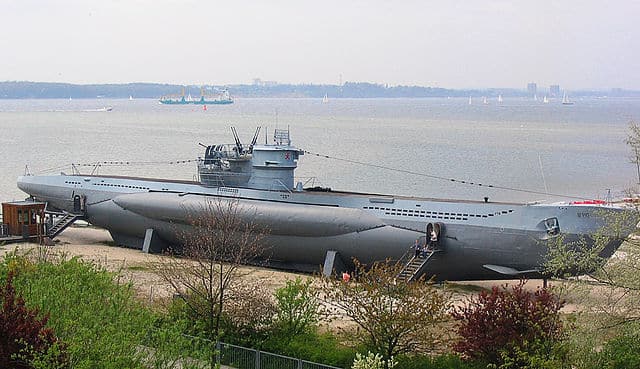
U995 at Laböe, used as a Museum
With that being said, the Type-VII was one of the best submarines of World War 2, and one of the most prolific, comparing the 700 boats to the 1,156 grand total of U-Boats built by Germany during the war. Last Type-VII decommissioned in 1970s Spain (See Spanish Submarines).
Genesis of the perfect U-Boat
Designs for the Type-VIIA went back as early as 1933, and it was chosen for production based on the following specs, in range, armament, ease of manufacture, and required manpower. In addition, the new submarine could not succeed a tonnage requirement set by England, which stated that the German Kriegsmarine could have 35% of the tonnage of the Royal Navy (1930 London treaty). The Type-VII therefore had to be relatively small to be be built en masse before meeting this tonnage ceiling.
The Type UB-III of WWI (1917) was also the most prolific (90 boats built) and successful of German U-Boats in WW1. These 500-650 tons boats were 55,3 x 5,8 x 3,7 m. Their range was 13,300 to 16,700 km, they can dive to 50m, had five TTs, one or two 10.5 cm guns, could run at 13,5 knots in surface and 7,5 knots submerged.
The Type VII was based on earlier designs, which in fact went back to the Type UB III of late WWI. The cancelled Type UG in particular was its main inspiration. In 1930 engineers just had to recover the blueprints and start from this. The type UG was designed through the famous interwar dummy company Ingenieurskantoor voor Scheepsbouw Den Haag in the Netherlands to bypass the Treaty of Versailles interdiction.
The final product was then built by other shipyards. The Finnish Vetehinen-class and Spanish Type E-1 were ones of these. These designs led to the larger Type I built in AG Weser shipyard in Bremen, cut down after only two, but it was refined further to develop either the Type VII and Type IX, the two most produced and active U-Boats of the war.
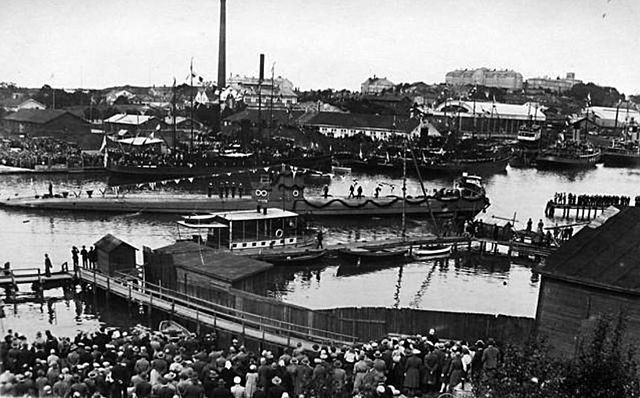
Launch of the Vetehinen.
Design details of the Type VII
The basics were a modernized UB-III, larger, reaching 900 tons in displacement, submerged and fully filled, almost ten meters longer, but with the same width, and larger draught at 4,37 m. The armament remained the same, five tubes, one in the stern and the other four in the bow, and a 88 mm deck gun. However the game changer was the modern powerplant, MAN-diesels and Korting electric units delivering 2310 hp on surface and 750 hp submerged. Top speed reached 17 knots, range 6200 nm. Also the tubes could load and fire 22 TMA mines, unlike the WWI model. Fast and slender, these boats were more strongly built, and this went ahead even more during WW2 as it was required to dive at great depths, the the brink of crushing.
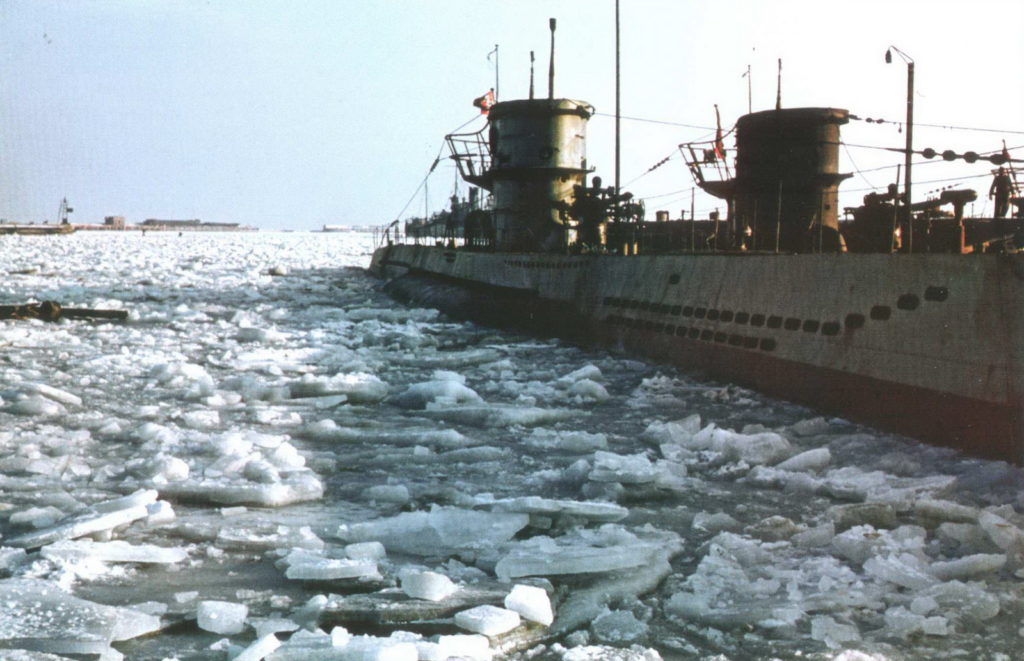
The UB-III could dive already well below 50 meters, and Type-VII in reality could down to 100 meters (Theoretical crushing depth was 90 m). The pressure hull was made with stronger thicknesses and this formidable resilience saved many crews. But the ‘tieffenmesser’ or depth indicator was graduated to 250 m and reports of dives down to 200 m has been made in tests. Indeed the 90 m were a manufacturer “adviced depth”, beyond which was declined any responsibility.
Responsible captains would test their brand new commissioned boat beyond this limit already to detect any leakings before the first mission, but in combat, captains routinely reported diving down to 150 m. In 1942, hull thickness on American submarines of the Balao class which had twice the Type VII size increased from 9/16-inch to 7/8-inch, plus a re-engineered trim pump with 600-foot operating capability.
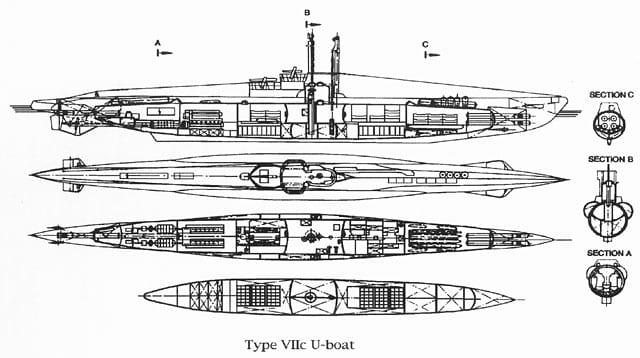
Overall view of the design, section by section
Design
The Type-VIIA had a length of 212 feet (65 meters), a draft of 15 feet (4 meters), and a beam of 19 feet (6 meters), with a displacement of 626 tons while surfaced and 745 tons while submerged.
Other variants of the Type-VII also existed, all with different features. The Type-VIIC, for example, had a length of 220 feet (67 meters), a draft of 16 feet (5 meters), a beam of 20 feet (6 meters), and a surface displacement of 769 tons, while the submerged displacement was 685 tons.
The hull was not very much larger than the original UB-III but with ten meters more, allowing an extra compartment to be added.
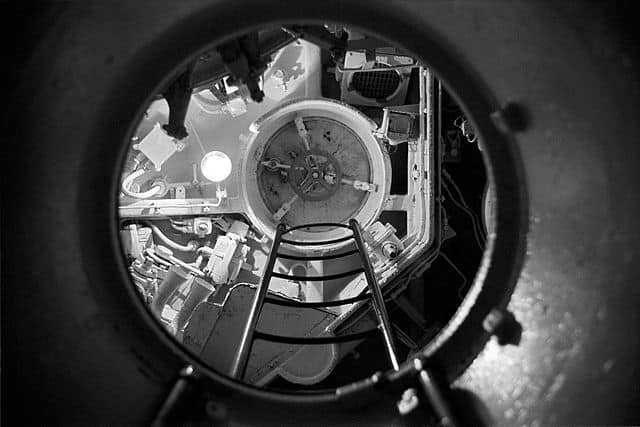
View of the Central
A conning tower that held the periscopes and anti-aircraft armament was situated in the middle of the sub. A deck gun was mounted on most Type-VIIs in front of the superstructure, however this was removed on some models as the war progressed, as surface attacks were too risky with Allied air supremacy in the Atlantic.
Armament
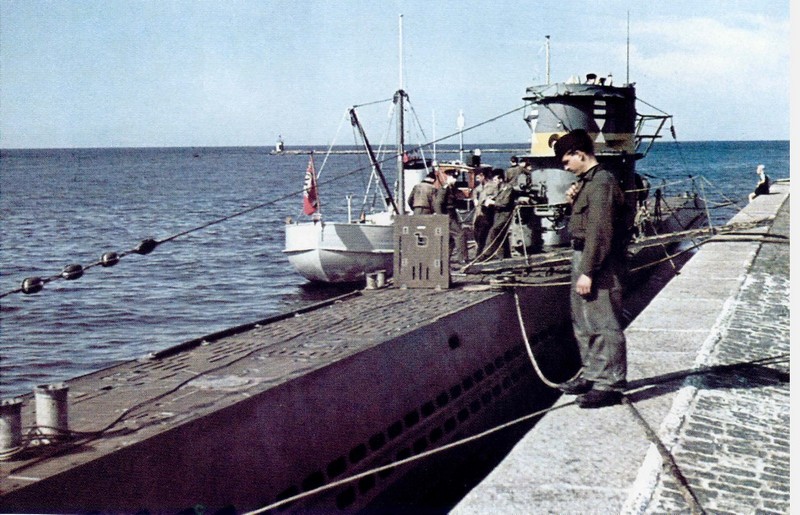
Armament of a standard, early war Type-VIIA was 1 88mm SK C/35 deck gun, mounted in front of the conning tower, and 1 20mm C/30 fully-automatic anti-aircraft gun, mounted on either the rear of the conning tower, or behind it on the deck.
While the main 88mm deck gun stayed the same on all of the Type-VIIs that is was fitted to, the anti-aircraft armament was different, depending on the time of war and the conning tower mounted on the sub. As the war continued and Allied aircraft became more of a threat, more modifications were conducted on the Type-VII’s conning towers to allow for more AA mountings. Many Type-VIIBs were fitted with 2 20mm AA guns, instead of just 1. Type-VIICs would often include a 37mm gun in their AA armament, and their 20mm guns would be mounted in twin mounts to improve effectiveness. On some boats, 20mm guns in quad mountings were also utilized.
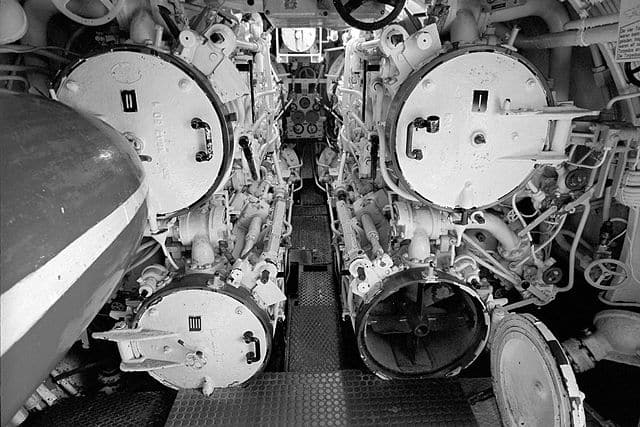
Torpedo Tubes room
As the war progressed and air raids became more frequent, especially over the Bay of Biscay, specialized “Flak-Traps” were designed in an attempt to shoot down allied aircraft. The first of the type, U-256, was equipped with 8 20mm cannons in 2 quad mounts, and according to at least 1 source, a 30mm cannon. However, it is more likely that this was a 37mm cannon and simply a typo or a mistranslation in the source. At least 4 of these “U-Flaks” were built, some with additional 20mm cannons in single or double mounts.
One of the more notable “U-Flaks” was the U-441, which had at least 2 quad 20mm cannons (Some sources list 4 quad 20s, although pictures of the sub would suggest otherwise), an experimental 37mm cannon, and an array of anti-aircraft rockets. Seeing as there were no more U-Boats fitted with the rockets, it is safe to say that they were unsuccessful.
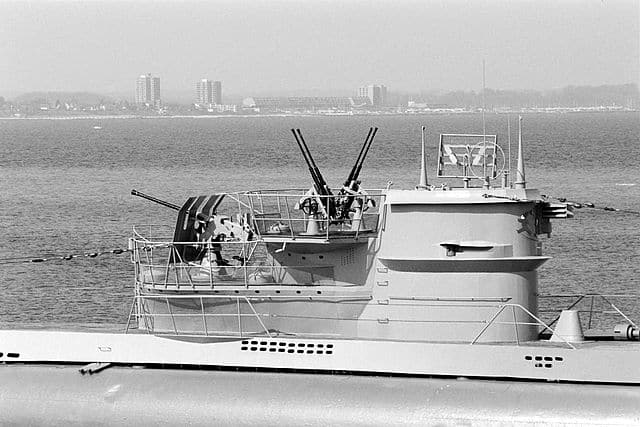
FLAK on board a late VIIC type
Keep in mind that for a submarine, the Type-VII class had exceptionally powerful surface armament when compared to other subs of the time. The Gato class, for example, might have 1 40mm Bofors cannon, 1 5inch cannon, and 2 20mm cannons in a double mount. Even other German subs had trouble competing with the Type-VII’s armament, such as the Type-II, which at most would be armed with 2 20mm cannons in single mounts, or the Type-XXI, the most advanced German submarine, with only 4 20mm cannons in 2 double mountings. The only submarine in the German arsenal at the time with a larger surface armament was the late model Type-IX, which could have a 105mm deck gun, along with a quad 20mm cannon, multiple twin 20mm cannons, and a 37mm cannon.
On all Type-VIIBs, Type-VIIDs, Type-VIIFs, and most Type-VIICs, there were 5 torpedo tubes (4 bow, 1 stern) with at least 14 torpedoes carried. Torpedoes used by U-Boats at the time were 534.6mm in diameter. On a Type-VII, they could be launched every 1.5 seconds at minimum to prevent interference or premature detonations that could happen if the torpedoes collided or came too close.
Type-VIIAs had 4 bow torpedo tubes that could be launched and reloaded from either the surface or subsurface, but the stern torpedo tube was external and above the waterline, meaning that it could only be fired and reloaded from the surface. On later variants, the stern torpedo tube could be fired and reloaded while underwater. Type-VIIDs also had vertical tubes behind the conning tower to launch mines. Type-VIIFs carried up to 39 torpedoes as they were meant to supply German subs in both the Atlantic and Indian Oceans, where German Type-IXs operated under the Monsun Gruppe. There were 5 Type-VIICs that had only 2 bow tubes, and 6 Type-VIICs with no stern tube.
It should be noted that all Type-VIIs could launch mines, not just the Type-VIID. Mine launching was done through the torpedo tubes instead of specialized, vertical tubes.
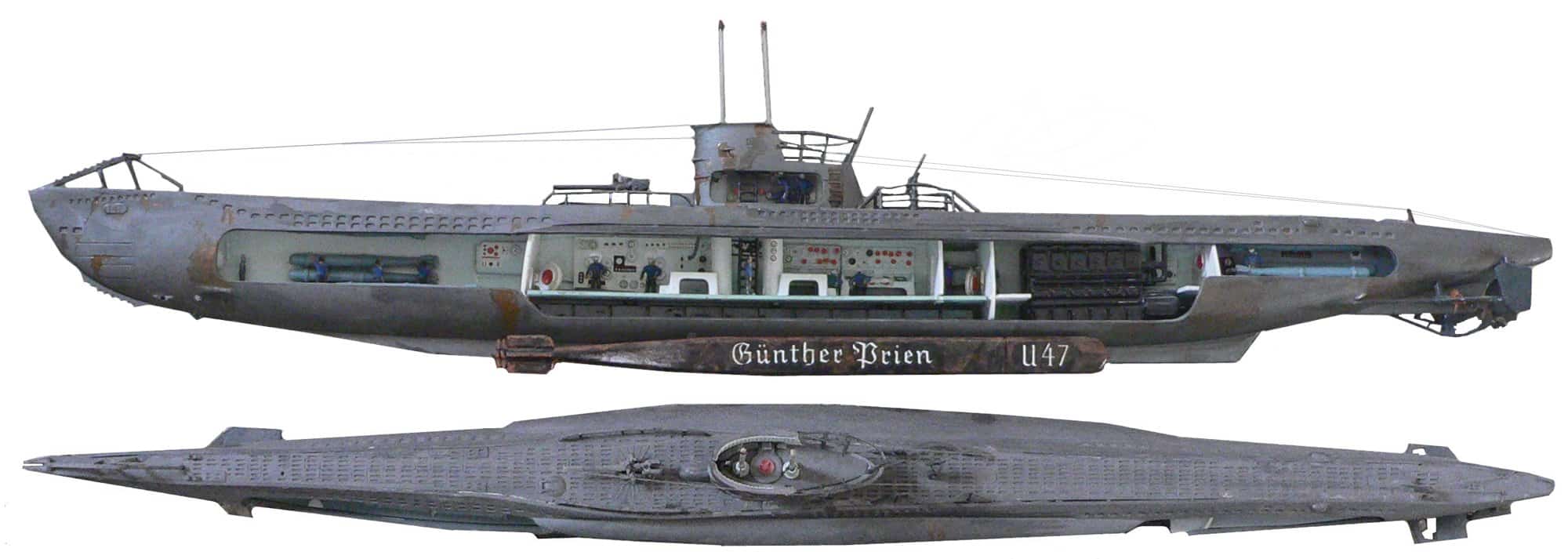
Model of U-47, Gunter Prien
Propulsion
The Type-VIIC was powered by 2 6-cylinder 4-stroke supercharged diesel engines with a combined horsepower of around 2,200 hp driving 2 3 bladed screws giving the sub a top speed of around 17.7 knots surfaced. Additionally, the sub was fitted with 2 double acting electric motors to use while submerged, giving around 750 hp and a submerged speed of around 7.6 knots.
Maximum range of the Type-VIIC was 6,500 nautical miles on the surface, which dwarfed the submerged range of 80 nautical miles, because by this range the sub would need to surface to charge the batteries.
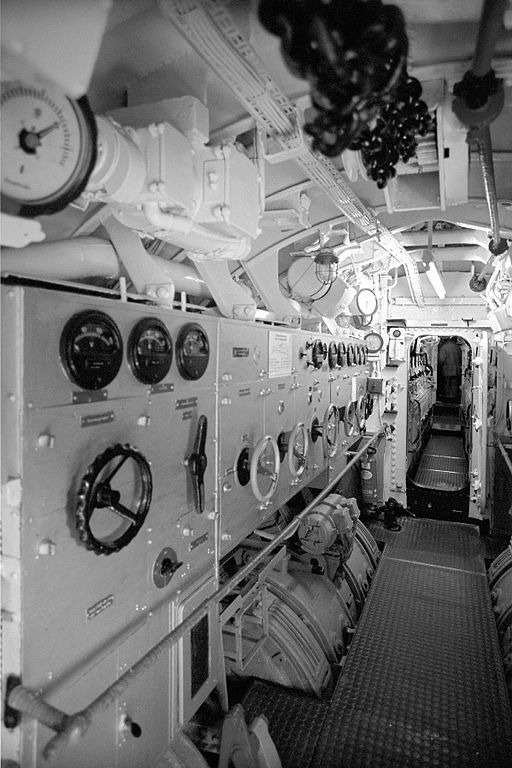
Engine room
Maximum crush depth of all Type-VIIs except for the Type-VIIC/41 was 200 meters (650 feet)- VIIC/41s could dive as deep as 250 meters (820 feet).
To increase the amount of time a sub could stay underwater, many German submarines were equipped with snorkel devices starting in 1944, however these only worked near the surface as the snorkel had to stick out of the water, exposing it to aircraft and other warships. Therefore, the snorkel was only really practical while the sub was not in combat.
Keep in mind that the speed and dimensions of all Type-VII variants differed as their needs and roles changed. The average unit cost of a German U-Boat of the time was 4,189,000 Reichmarks.
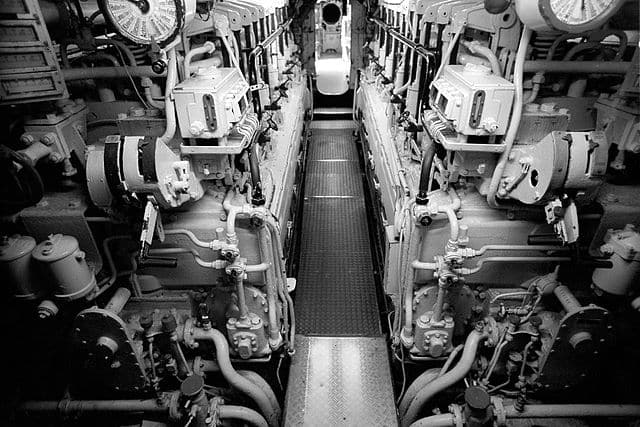
Diesels room
Production
With over 1,000 Type VII C manufactured or started one could appreciate the gigantic industrial effort Germany was in. The topic is as interesting as the career of the boats themselves. In short, the Type VII was built in time in all major yards previously used for the Kriegsmarine, including Neptun Werft at Rostock, Deschimag in Bremen, Germaniawerft in Kiel, Flender Werke at Lübeck, Danziger Werft (Danzig), Blohm & Voss at Hamburg, Kriegsmarinewerft at Wilhelmshaven, Nordseewerke in Emden, Schichau-Werke in Danzig, and Howaldtswerke AG in Kiel.
Read More
https://www.naval-encyclopedia.com/ww2/Nazi-Germany/u-boats-german-submarines
https://sci.military.naval.narkive.com/YyZWfqs2/ww2-submarines-diving-depths
https://uboat.net/technical/
https://uboat.net/types/viia.htm
http://www.uboataces.com/
//en.wikipedia.org/wiki/Category:German_Type_VIIA_submarines
USN Archives – Results of USN and German ASW campaigns ww2
Conway’s all the world’s fighting ships 1922-47
Möller, Eberhard; Brack, Werner (2004). The Encyclopedia of U-Boats.
Gröner, Erich (1990). German Warships 1815–1945
Helgason, Guðmundur. U-Boat War in World War II
Busch, Harald (1955). U-Boats at War.
Rossler, Eberhard (1981). The U-Boat.
Stern, Robert C. (1991). Type VII U-boats.
Active Service
While the Type-VII was an innovative submarine and arguably the best Germany had to offer during the war, it was doomed from the start of the war by 2 major events: The invasion of Poland by Germany and the sinking of the civilian liner RMS Athenia by U-30.
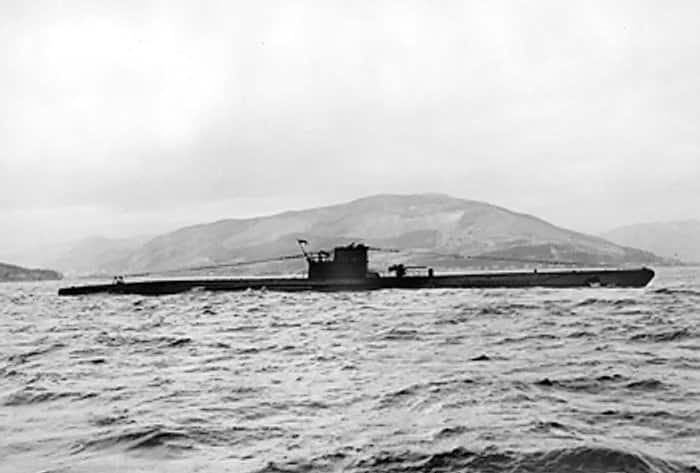
U-Boat type VIIC U570 at sea
Before the war’s start, Vice-Admiral Karl Donitz requested 300 U-Boats. With this, he thought, the Kriegsmarine could starve the British Isles into submission without a full land invasion. However, on September 1st, 1939, Nazi Germany invaded Poland, marking the beginning of World War 2. Of the 300 subs Donitz requested, only 57 were were available, and only about half of these could be fielded at any given time. Without the submarines that Donitz needed, there was no hope for the Kriegsmarine, at least at the start of the war.
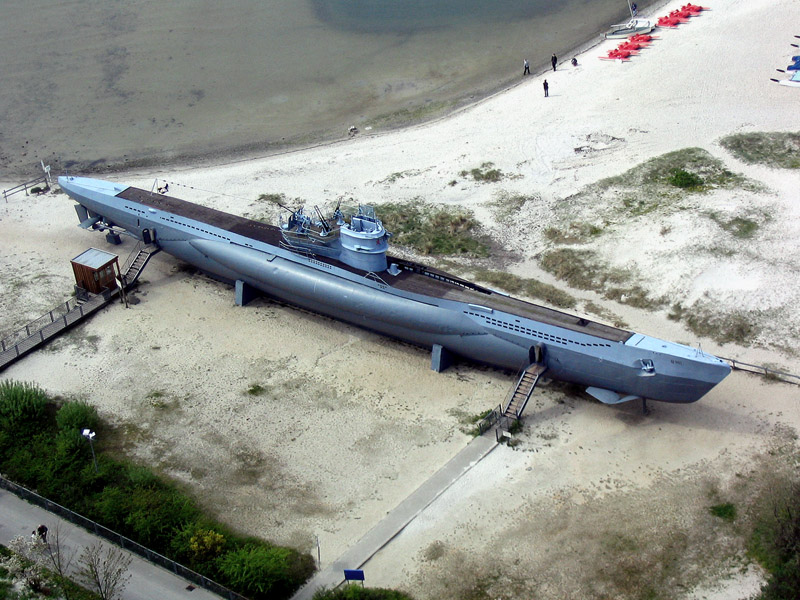
Aerial view of U995 at Laböe
On September 3rd, 1939, 2 days after the invasion of Poland, hostilities were declared with France and Great Britain. All German U-Boat crews on patrol received the message:
“To all captains and commanders at sea:
Great Britain and France have declared war on Germany. Act in compliance with the rules of engagement issued by navy command.”
Not 8 hours later, U-30, a Type-VIIA commanded by Kapitan-Leutnant Fritz-Julius Lemp, spotted British cruise liner RMS Athenia and engaged with torpedoes. At least 1 hit was scored, causing the Athenia to sink. The fact that a civilian liner was sunk by a German submarine shocked and enraged the Western world, including the United States, as there were American citizens killed in the attack. New tactics were quickly developed to keep freighters and civilian ships safe from U-Boot attacks. Convoys were formed, escorted by aircraft and destroyers, mainly by England but American ships would also escort convoys near the Eastern Coast.
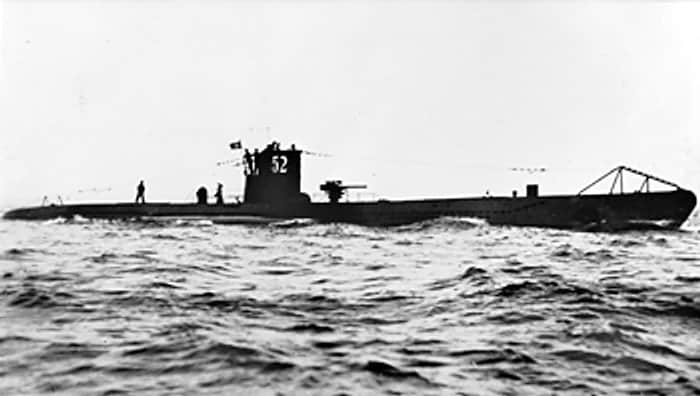
Type VIIB, U-52
Despite the growing air and naval presence of the Royal Navy, the German Type-VII would serve until 1945 in the Kriegsmarine, and until 1970 with the Spanish navy. It would be supplemented by the Type-IX and, at the very end of the war, the Type-XXI class.
Facts & Figures about U-Boats
Nitty-Gritty Details: Type VIIC
Tanks & storage
The VIIC was given 3 Main ballast tank, the largest of 47.750m³ working volume, two regulating tank 2 stb. two aft trim tank, a Forward trim tank, three torpedo compensating tanks, three Fresh water tanks, a Wash water tank in the Listening room, two Waste water tanks, two Negative buoyancy tank either side. Fuel oil tanks comprised three ballast and reserve fuel oil tanks, two regulating and reserve fuel oil tank, two main oil tank and a collecting tank, four lubricating oil supply tanks and dirty lubricating oil tank, a Fuel oil gravity feed tank, a Lubrication oil daily service tank, a Wash water daily suppl and a brine tank, as well as a Water distillate tank.
For storage, the Type VIIC was given a box for flare shells, one for demolition charges, an Ammunition magazine, Provisions storage aft & forward.
Torpedoes
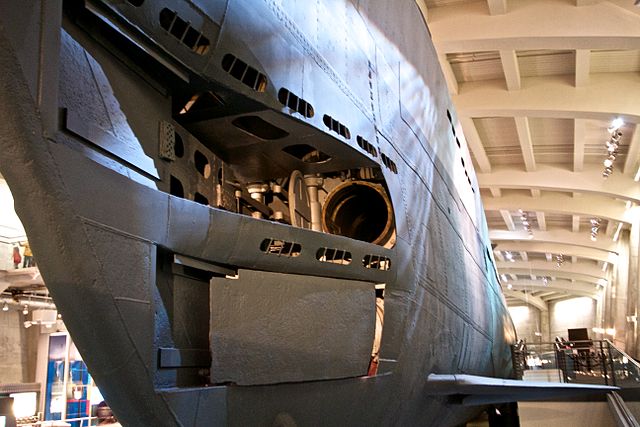
For the Torpedo tubes I – V, Piston was 70 kg, forward +25.25 with piston inserted, 1680m3 and aft: -26,15 without piston and 1740m3. There was an upper deck container forward and aft, with and without G7A. Torpedo in the tubes were the G7E/G7A models. There was also a reserve stowage forward, aft.
G7A Torpedoes
The G7a (TI) torpedo caliber was the standard 533.4 mm (21 in), for a lenght of 7163 mm (23 ft 6 in), fitted with a Ka or Kb warhead, Pi1 or Pi2 pistol. The warhead carried 280 kg (617lbs) Schießwolle 36. The model remained standard issue from 1936 to the end of WW2. This model was of a straight-running unguided model only controlled by a gyroscope. It could be set at a variable speed, 5,000 m at 81 km/h or 7,500 m at 74 km/h (8,250 yd at 40 kt) but also “long course” 12,000 m at 55.6 km/h. The 44 knots model setting was only used by Schnellboote with a reinforced engine.
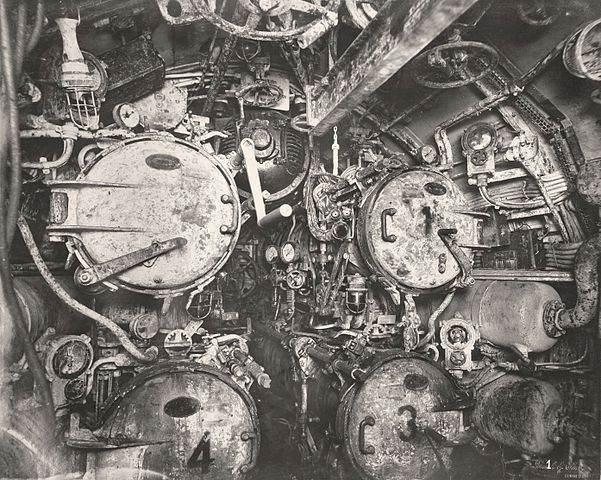
The TI or G7A was also the last German torpedo with a wet heat propulsion, as she was powered by a mixture of compressed air and steam. Decaline fuel was used. It filled a combustion chamber, creating steam from fresh water and the speed was setup by pressure along three settings, starting at 30 knots and up to 44. The regulator feeding air to the bottom of the combustion chamber could be setup before launch by the operators before it was loaded inside the tube. The superheated steam powered a four cylinder reciprocating engine which drove a short shaft fitted with contra-rotating propellers.
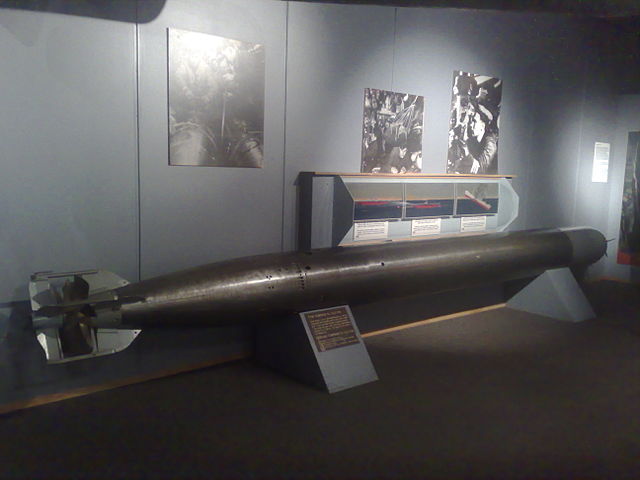
The model boasted excellent speed and endurance but was very noisy and generated a large wake of bubbles. Only the Japanese Type 93 and Type 95 fuelled by enriched oxygen were “invisible”. But this wake was less visible at night, where the model was most used whereas in daytime electric torpedoes were preferred. The early tested combined mechanical/magnetic exploder but the model was introduced too soon, showing bits of deep running and premature explosion problems. This amounted to a global 30% failure rate early in the war, to the dismay of Admiral Dönitz saying, “…never before in military history has a force been sent into battle with such a useless weapon.”
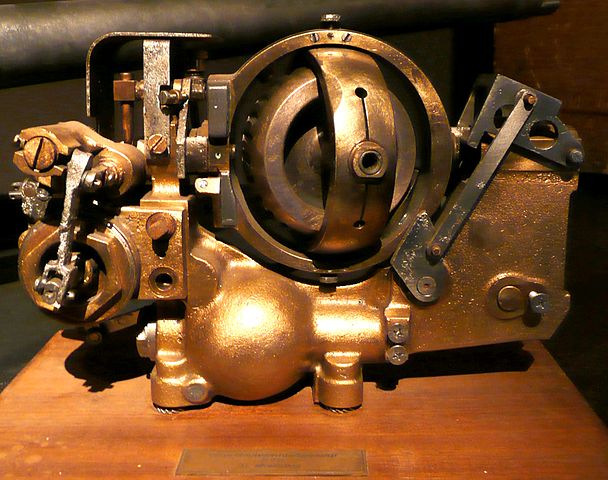
Gyroscope G7A
The only preserved Type VII: U995 at Laboe
The U-995 was specifically a Type VIIC/41, laid down on 25 November 1942 in Hamburg. She was commissioned on 16 September 1943 (Oberleutnant Walter Köhntopp) and was anchored on 8 May 1945 at Trondheim, Norway, not active because of the lack of fuel. She surrendered to the British, and then transferred to Norwegian ownership in October 1948. In December 1952 she became the Kaura and served with the Royal Norwegian Navy until stricken in 1965. She sold for one symbolic Deutsche Mark to Germany and after some restoration work she opoened to the public as a museum ship in October 1971 at the Laboe Naval Memorial where she stays since then. She can be visited as the oly example of an authentic wartime U-Boat. The other one was an imitation made for the movie “Das Boote”.

Blueprints of the Type VIIC/41
About “Das Boote” (1982)
Wolfgang Petersen’s legendary submarine movie remains perhaps the best ever made for this era and genre. A reference for all following submarine dramas ever since. Featuring guest star Jürgen Prochnow as her Grizzly captain and an all-German crew (in every sense of the term), this gritty, realistic drama made no concessions to the fate of German submariners in this era, depicting a serie of missions between the Atlantic and Mediterranean.
It was nominated, rightfully so, at the Oscars 1983’s as Best Director, Best Writing, Best Cinematography, Best Sound, Best Film Editing, Best Effects, Sound Effects Editing, a record for a Foreign film. Das Boot (“The boat”) was also nominated as Best Foreign Film at BATFA and Golden Globe, won at the Bavarian and German Film Awards, Golden Camera and Golden Screen.
Imdb best summarized it as “The claustrophobic world of a WW2 German U-boat, with boredom, filth and sheer terror.
The movie was based on a book by Lothar G. Buchheim, loosely based on the VIIC boat U-96 and captain Heinrich Lehmann-Willenbrock. It is based on Buchheim’s own recollections of his war correspondant job in this U-boat in late 1941 (impersonated by Werner in the movie), giving a documentary luster to the whole story. For the anecdote John Sturges wanted to adapt the book first but later dropped the project and was amazed later when discovering the work of Petersen, calling it a ‘claustrophobic masterpiece’.

Das Boote can be seen today as the movie complement to a visit to Laboe. Interestingly, the U-Boat used for the movie ate most of the $15 million budget spent. Construction called for specifications of the original Type VII-C blueprints found at the Chicago Museum of Science and Industry.
One of the original builder of this serie was tasked to rebuilt a full-sized, sea-going replica for external scene while a second full-sized model was built only for interior filming. The original Bunkerized U-Boat pens at St Nazaire, Britanny, France, were used for part of the filming. Both the submarine and pens were shoot also in Indiana Jones: Raiders of the lost Ark in 1981.
Sources:
Conway’s all the world’s fighting ships 1921-47
wikipedia.org/wiki/German_Type_VII_submarine
uboat.net/types/viic.htm
uboat.net/types/u-flak.htm
www.uboataces.com/uboat-type-vii.shtml
Type VII by Marek Krzysztalowicz
U-Boote by Jean-Philippe and Dallies-Labourdette
uboatarchive.net Manual Type VIIC
//www.warhistoryonline.com/military-vehicle-news/take-look-inside-a-u-boat-images.html
The U-Boat Type VII by Robert Cecil Stern
Type VII U-Boat (Anatomy of the Ship) by David Westwood
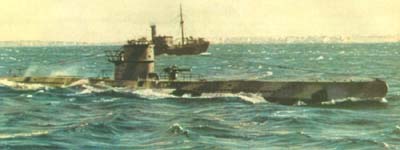
Camouflaged U760
The Models corner:
>Revell 1/350 Type VIIC
>Flagman 1/350 Type VIIC
>Revell 1/350 Type VIID
>Revell 1/144 Type VIIC/41 Atlantic
>Revell 1/144 Type VIID Minenleger
>Revell 1/125 U-47 cutout
>Revell 1/125 U-99
>Revell 1/72 U-boat Type VII C
>AFV club 1/350 Type VIID
>AFV club 1/350 Type VIIB
>AFV club 1/350 Type VIIC/41
>DKM Hobby Boss 1/350 Type VIIC
>DKM Hobby Boss 1/350 Type VIIB
>DKM 1/700 Type VIIB
>Mirage Hobby 1/400 VIIC/41 U-295
>Mirage Hobby 1/400 VIIC U-84
>Mirage Hobby 1/400 VIIC U-571
>Mirage Hobby 1/400 VIIC U-673
>Mirage Hobby 1/400 VIIC U-826
>Mirage Hobby 1/400 VIIC/41 U-1064
>Flyhawk models DKM Type VIIB 1/700
>Flyhawk models DKM Type VIIB 1/700 U-48 with dock
>Super-Hobby 1/72 Type VIID
>Trumpeter 1/48 Type VIIC U-552
>Heller 1/400 Type VIIC & Laubie
>Airfix 1/400 Type VIIC
>Modelcraft 1/150 Type VIIC U-581
>Arkmodel Kit 1/48 Type VIIC Submarine
See also:
missing-lynx.com/reviews/48/arkmodel7602kreviewlp_1.html
scalemates.com/search.php?fkSECTION%5B%5D=Kits&q=Type+VII*
Games Corner: Type VII simulators
-Subsim
-Silent Hunter
-Ll-3
3D Corner
Type VIIC 3 Warehouse
The Type VII on Turbosquid
On stlfinder.com
On 3dcadbrowser.com
On cgtrader.com
On grabcad.com
Cutaway version on blenderartists.org
On assetstore.unity.com
Gallery
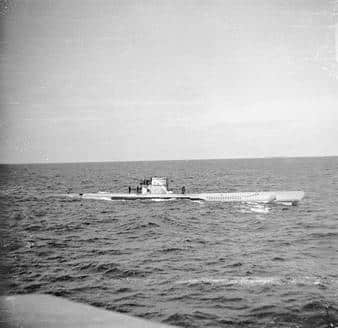
U-660
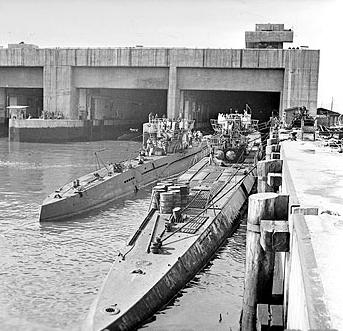
Trondheim U-boat pens, a Type VII and Type XXI interned before being shipped as war reparations.

Type VIIA, 1/350 scale by the author (1936/37)
The Type VII is the most prolific series of submersibles in history, a record that has never been surpassed, with nearly 709 units built, including the Kriegsmarine. Many more were never completed, and a considerable number of variants. Type VII alone will be enough to bring the British to their knees, or at least they were able to do so several times during the battle of the Atlantic and the convoys of Murmansk. Very balanced, type VII was derived from the mediocre Type I, as a “standard” oceanic, capable of a return trip and stations in the Atlantic for more than two months.
It was not, however, a complete success on all levels, but was relatively simple to build, reliable, and extremely robust. The depth of crushing, theoretically 230 meters, was in fact often repulsed in practice to 250 meters, or even more. It was calculated that it was necessary to descend to about 290 meters (variable according to the units whose manufacturing quality evolved towards the mediocre in 1944) to cause the loss of the building. This result was very honourable because of their simple hull design (all modern submersibles have a double hull), the hull of the pession being furnished with lateral reinforcements.
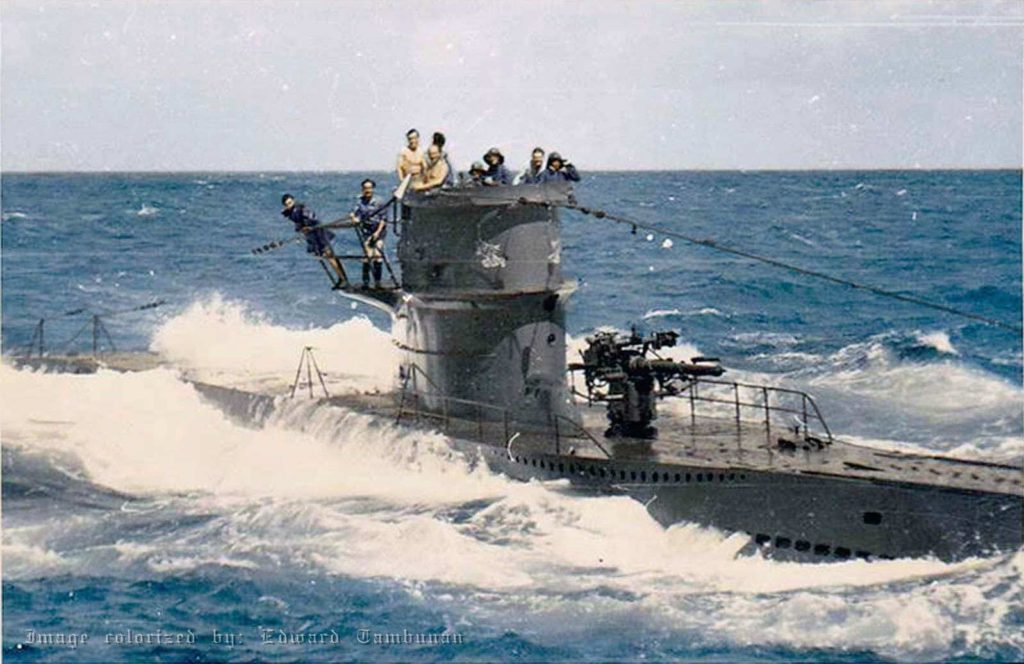
Type VIIC at sea crossing the path of another u-boat (which took this photo). Colorized by Edward Tambunan.
The preliminary drawings date back to 1934, from the outset a more modest, economical version of the Type I was envisaged, and the same ones were based on the Spanish E1 and the Finnish Vetehinen. They were constructed using soldering, large ballast tanks, efficient sinking speed, double hull and oil reserves giving them considerable autonomy, although cargo vessels were anchored in neutral ports And even submersibles “cash cow” for remote operations (such as the campaign on the American coasts early 1942).
These boats spent all their time on the surface, except in exceptional cases of very heavy weather, or of course attack, their performance in diving remains mediocre: about 150 km at 4 knots. The reliability of their MAN diesels did much for their fame. The latter were six-cylinder four-valve 40/46 giving from 2100 to 2300 hp and rotating at 470/485 rpm. These performances valid for type A, evolved subsequently.
Ten (U27-U36) Type VIIA were produced in 1936, admitted to active duty in 1936-37. They were the cornerstone of U-Bootes’ strength before entering the war. They were all lost to battle.
Type VII manufacturers were: Neptun Werft, Rostock, Deschimag, Bremen, Germaniawerft, Kiel, Flender Werke, Lübeck, Danziger Werft, Danzig, Blohm + Voss, Hamburg, Kriegsmarinewerft, Wilhelmshaven, Nordseewerke, Emden
By 1942, the construction had begun to be rethought in modular terms to improve the production rate. But it was only with type XXI and type XXIII that we arrived at a veritable “mass production” with a very strong modularization.
Displacement & Dimensions: 626t surface / 745t dive and 64,5 x 5.80 x 4.40 m
Propulsion: 2 propellers, 2 MAN diesels, 2 electric motors, 2100/750 hp. And 16/7 knots surface/dive
Miscellaneous:Crew 44; RA: 4300 nm @12 knots, max depth 200 m dive time 22 sec.
Armament: 1x 88 mm, 1x 20 mm AA, 5x TLT 533 mm (4 av, 1 ar, 11 torpedoes), 22 mines TMA or 33 TMB

Type VIIB, 1/350 scale by the author (1939-40)
The U-Boats type VIIB had a slightly elongated hull, larger ballasts and tanks with more capacity. Their range of action was therefore increased to 4300 nautical at good speed and to 6500 on a cruise. A system of super-injection of the diesels made it possible to win a knot in emergency situations. Finally, the torpedo capacity was increased to 14, stored in the upper part of the pressure hull, a distinct advantage which greatly increased their operating time. Finally, propellant control surfaces were added, improving the maneuverability and releasing the space for the rear torpedo tube which could now be accessed from the inner shell (and therefore recharged). 24 units of these excellent buildings, produced and improved by the first experiments in operations, were accepted in service in 1939-1940. They formed the basis of the famous C type.
Displacement & Dimensions: 753t surface / 857t dive and 66.5 x 6.20 x 4.40 m
Propulsion: 2 propellers, 2 MAN diesels, 2 electric motors, 2100/750 hp and 17.2/8 Knots surface/dive
Miscellaneous Crew 44; RA: 6500 nautical at 12 knots, Prof. Crushing 200 m; lives. plunged. 22 sec.
Armament: 1 barrel of 88 mm, 1 barrel of 20 mm AA, 5 TLT 533 mm (4 av, 1 ar, 14 torpedoes), 26 mines TMA/39 TMB

Type VIIC Flak-U of 1944, 1/350 scale by the author (1941-45)
The following U-Boats, type VIIC, reached the pinnacle of the medium oceanic type. Derived narrowly from B type, they had an additional central space enlarged by 60 cm to accommodate a sonar of a new type. The oil filter, the air compressor, electrical distribution system were modernized and improved. Construction remained close to type B, which facilitate production tooling. In total, 577 (568 or 593 according to other sources) units were commissioned, which remains an absolute record for this type of ship (above the 236 cold war Soviet “Whiskey” type and well above the larger ww2 “Gato” type). Type VIIC were produced until 1945, 150 being in construction sites on V-day, carrying by far the bulk of the Kriegsmarine effort in the Atlantic.

U Boat VIIC, side and top view
Numerous variants were derived, including the supply variants (with only two TLTs at the front) and the famous variant “U-flak”, U for “unterseeboote”. The latter were four units equipped with a 37 mm gun and two 20 mm Flamvierling quadruple shafts. They ensured the aerial coverage of the pack on the surface. Their success in 1943 was short-lived when the RAF operated its airplanes in concert with fast escorts.
They were derived from the previous U256, converted in 1942. They tried with the latter a battery of 86 mm AA The concept was not followed. These “Flak U” destroyed only six aircraft and soon returned to their classic role. The air supremacy of the RAF and Coastal Command in the Bay of Biscay made these attempts desperate. Dönitz was forced to ask his submariners to cross this zone at full speed to reach the center of the Atlantic (or the air cover stopped), even if it meant reducing their autonomy.
Many type C survived the conflict, most were given as compensation to the allies, some being exposed, others sailing for the cinema like the U96 that served the famous film Petersen, “Das Boot”. They were followed by variants C/41 and C/42.
Displacement & Dimensions: 761t surface/865t sub and 67.2 x 6.20 x 4.80 m
Propulsion: 2 propellers, 2 Germaniawerft 40 diesels with compressor, 2 electric motors, 2100/750 hp. And 17.2/7.6 knots Surface/dive
Miscellaneous: Crew 44; RA: 6500 nautical at 12 knots, Prof. Crushing 200 m; lives. plunged. 22 sec.
Armament: 1 barrel of 88 mm, 1 barrel of 20 mm AA, 5 TLT 533 mm (4 av, 1 ar, 14 torpedoes), 26 mines TMA/39 TMB

Type VIID, 1/350 scale by the author
The VIIDs were an enlarged version of the VIIC types, with a length of 76.90 meters and a width of 6.40 meters, to accommodate 5 large vertical tubes placed behind the kiosk and intended to accommodate 15 heavy SMA mines (Three per tube). They had been conceived in the express design of anchoring mines in front of the great ports of the American coast, possibly mining also the Panama canal.
FLAK was also reinforced, with one 37 mm cal 83 C30 and several 20 mm c30. Six were launched at Krupp, Germaniawerft, operational in 1942, one of which effectively mined the entrance of the port of New York, causing mayhem for a short time. All but one, the U218 (surrendered to the US Navy in 1945) were sunk in action. The VIIE type was an experimental model with a new, lighter and more powerful V12 diesel model, allowing a thicker hull for deeper diving. But the engine posed too many problems and the program ended in a dead end.
Displacement & Dimensions: 965t surface/1080t dive and 76.9 x 6.38 x 5.00 m
Propulsion: 2 propellers, 2 Germaniawerft 40 diesels with compressor, 2 electric motors, 3200/750 hp. And 16.7/7.3 knots Surface/dive
Misc: crew 46-52; RA: 11,200 nautical miles at 12 knots, Prof. Crushing 200 m; lives. plunged. 22 sec.
Armament: 1 gun of 37 mm, 1 gun of 20 mm AA, 5 TLT 533 mm (4 av, 1 ar, 12 torpedoes), 41 mines TMA / 39 TMB

Type VIIF (1943) 1/700 scale by the author
The type F was a modified version of the type D, basically a submarine tanker. In 1942, most of the German supply ships for the Atlantic had been lost and the last ones sailed at great risk because of the RAF and a more present US navy. As a result, “submersible tankers” were designed with an additional section of about ten meters behind the kiosk to house torpedoes and ammunition, fuel and food.
Their capacity was nevertheless reduced to two supplies, after which their own offensive cruise could take place. Their 88 mm gun was subsequently dropped and a 20 mm double hub rear extension of the kiosk was managed. These were the U-1059, 1060, 1061 and 1062, all lost at sea except the U1061, captured by allied troops in 1945. In practice, the torpedo supply at sea proved dangerous, slow and painful, since mild weather was pretty rare in the North Atlantic.
Beginning in 1944, this serie ended as long range cargos, delivering in Japan to deliver new models of torpedoes and other strategic assets.
Displacement & Dimensions: 1067t surface / 1162t dive and 77.60 x 7.30 x 4.90 m
Propulsion: 2 propellers, 2 MAN diesels, 2 electric motors, 2400/750 hp. And 16.9/7.9 knots Surface/Diving
Misc: Crew 46; RA: 9200 nautical at 12 knots, Prof. Crushing 200 m; lives. plunged. 22 sec.
Armament: 1x 88 mm, 1x 20 mm AA, 5 TLT 533 mm (4 av, 1 ar, 14 torpedoes), 26 mines TMA/39 TMB


Type VIIC/41, VIIC/42 (1942-45) 1/750 scale by the author
The U-Boats type VIIC/41 to 43 were variants of the most prolific submersible class in history, a synthesis of modifications and improvements inspired by war experience since 1939. For type VIIC/42, the urgency was to allow to dive deeper. With a reinforced shell by a thickening from 18 to 21 mm in places, this became possible, but at the cost of all that was not necessary, a cure of weight that made these ships lighter overall, to reach 250 meters and more. 88 units of this type were built. During the war, their simple 20 mm Flak mount was replaced by a twin one, and their 88 mm now obsolete was deleted.
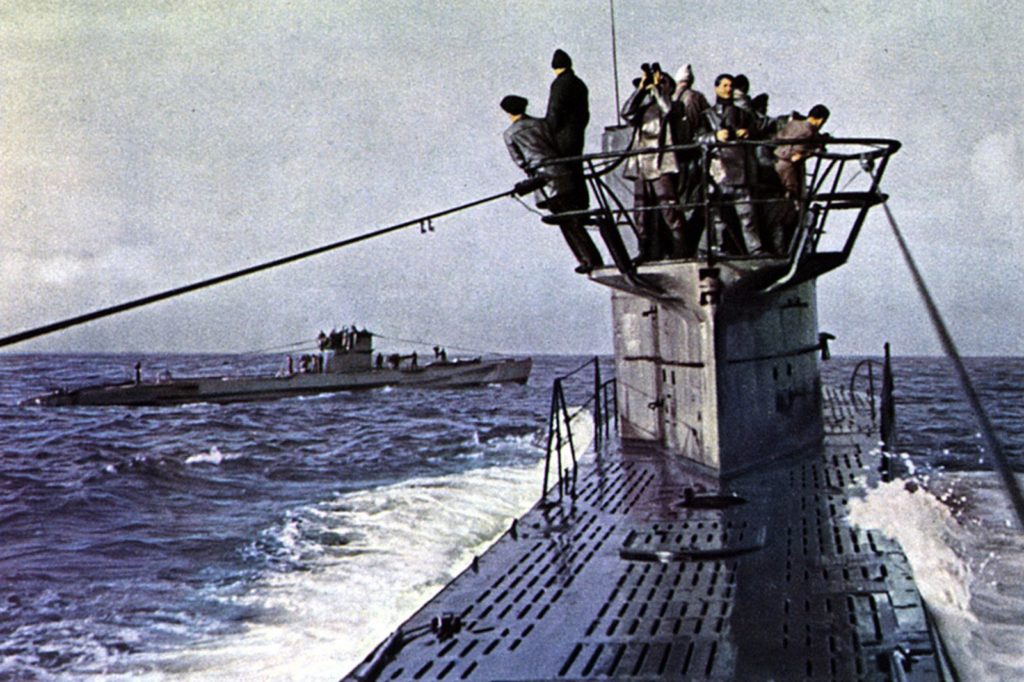
The next type 42 combined this weight cure with a new compressed diesel engine enabling a record autonomy of 10,000 nautical miles at 12 knots, the surface speed increasing to 18.6 knots and above all the Hull was enlarged and used reinforced steel normally used for shielding plates, to some places up to 28 mm. These modifications would have allowed a theoretical immersion depth of 500 meters. But none of the 165 authorized was ever completed. Most were captured by the allies under construction in April-May 1945. Type VIIC/43 never went beyond the drawing board stage. This had additional torpedo storage space and no less than 10 torpedo tubes, 6 front and 4 rear.
The following characteristics apply to type 41:
Displacement & Dimensions: 759t surface/860t dive and 67.20 x 6.20 x 4.80 m
Propulsion: 2 propellers, 2 MAN diesels, 2 electric motors, 2400/750 hp. And 17/7.6 knots Surface/dive
Miscellaneous Crew 44; RA: 6500 nm @12 knots, max depth 250 m, speed 18 sec.
Armament: 1/2x 20 mm AA, 5 TLT 533 mm (4 av, 1 ar, 14 torpedoes), 26 mines TMA/39 TMB
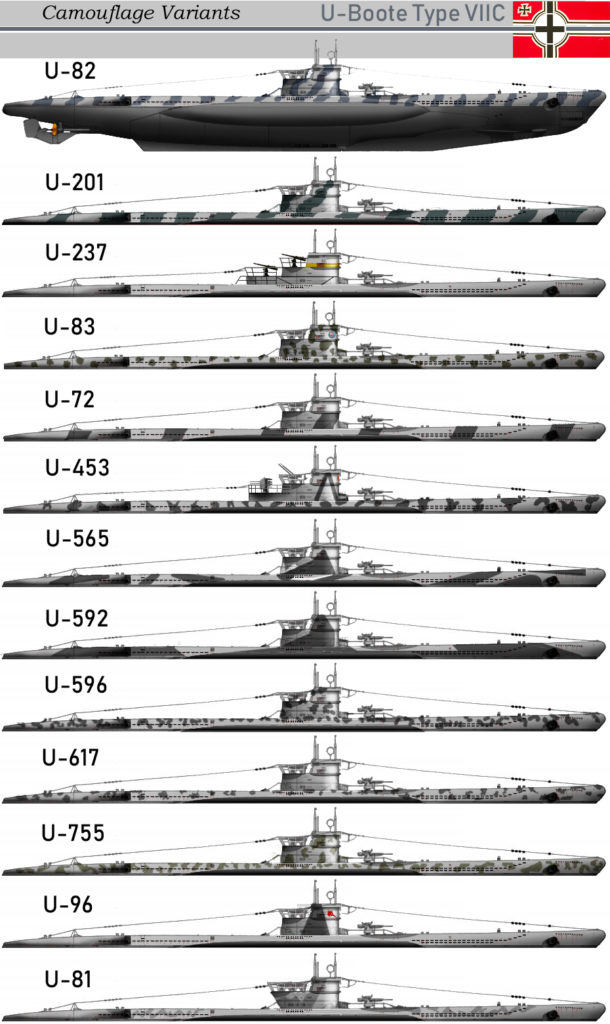
Camouflage liveries of the Type VIIC
An article started by Will5stars and completed by David Bocquelet (Dreadnaughtz)

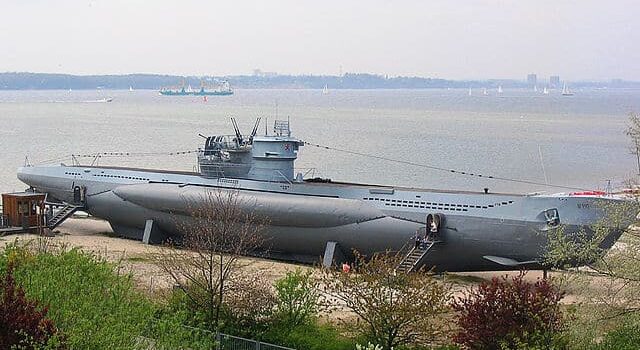

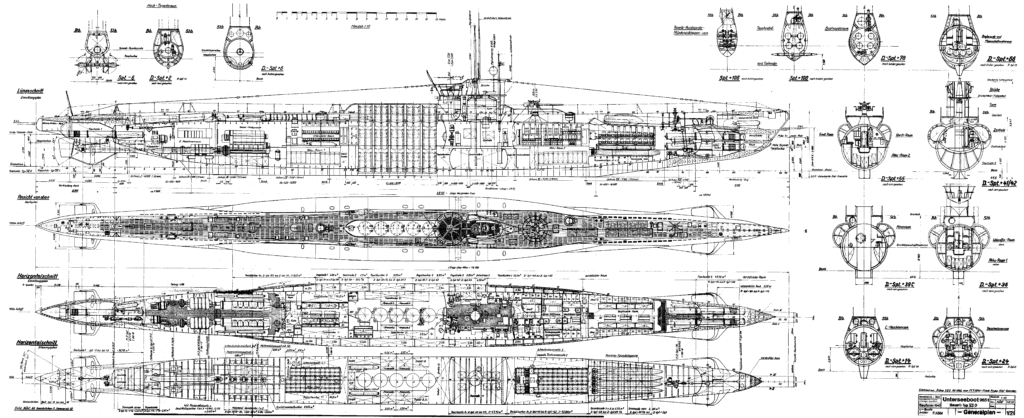
 Latest Facebook Entry -
Latest Facebook Entry -  X(Tweeter) Naval Encyclopedia's deck archive
X(Tweeter) Naval Encyclopedia's deck archive Instagram (@navalencyc)
Instagram (@navalencyc)





 French Navy
French Navy Royal Navy
Royal Navy Russian Navy
Russian Navy Armada Espanola
Armada Espanola Austrian Navy
Austrian Navy K.u.K. Kriegsmarine
K.u.K. Kriegsmarine Dansk Marine
Dansk Marine Nautiko Hellenon
Nautiko Hellenon Koninklije Marine 1870
Koninklije Marine 1870 Marinha do Brasil
Marinha do Brasil Osmanlı Donanması
Osmanlı Donanması Marina Do Peru
Marina Do Peru Marinha do Portugal
Marinha do Portugal Regia Marina 1870
Regia Marina 1870 Nihhon Kaigun 1870
Nihhon Kaigun 1870 Preußische Marine 1870
Preußische Marine 1870 Russkiy Flot 1870
Russkiy Flot 1870 Svenska marinen
Svenska marinen Søværnet
Søværnet Union Navy
Union Navy Confederate Navy
Confederate Navy Armada de Argentina
Armada de Argentina Imperial Chinese Navy
Imperial Chinese Navy Marinha do Portugal
Marinha do Portugal Mexico
Mexico Kaiserliche Marine
Kaiserliche Marine 1898 US Navy
1898 US Navy Sovietskiy Flot
Sovietskiy Flot Royal Canadian Navy
Royal Canadian Navy Royal Australian Navy
Royal Australian Navy RNZN Fleet
RNZN Fleet Chinese Navy 1937
Chinese Navy 1937 Kriegsmarine
Kriegsmarine Chilean Navy
Chilean Navy Danish Navy
Danish Navy Finnish Navy
Finnish Navy Hellenic Navy
Hellenic Navy Polish Navy
Polish Navy Romanian Navy
Romanian Navy Turkish Navy
Turkish Navy Royal Yugoslav Navy
Royal Yugoslav Navy Royal Thai Navy
Royal Thai Navy Minor Navies
Minor Navies Albania
Albania Austria
Austria Belgium
Belgium Columbia
Columbia Costa Rica
Costa Rica Cuba
Cuba Czechoslovakia
Czechoslovakia Dominican Republic
Dominican Republic Haiti
Haiti Hungary
Hungary Honduras
Honduras Estonia
Estonia Iceland
Iceland Eire
Eire Equador
Equador Iran
Iran Iraq
Iraq Latvia
Latvia Liberia
Liberia Lithuania
Lithuania Mandchukuo
Mandchukuo Morocco
Morocco Nicaragua
Nicaragua Persia
Persia San Salvador
San Salvador Sarawak
Sarawak Uruguay
Uruguay Venezuela
Venezuela Zanzibar
Zanzibar Warsaw Pact Navies
Warsaw Pact Navies Bulgaria
Bulgaria Hungary
Hungary

 Bundesmarine
Bundesmarine Dutch Navy
Dutch Navy Hellenic Navy
Hellenic Navy Marina Militare
Marina Militare Yugoslav Navy
Yugoslav Navy Chinese Navy
Chinese Navy Indian Navy
Indian Navy Indonesian Navy
Indonesian Navy JMSDF
JMSDF North Korean Navy
North Korean Navy Pakistani Navy
Pakistani Navy Philippines Navy
Philippines Navy ROKN
ROKN Rep. of Singapore Navy
Rep. of Singapore Navy Taiwanese Navy
Taiwanese Navy IDF Navy
IDF Navy Saudi Navy
Saudi Navy Royal New Zealand Navy
Royal New Zealand Navy Egyptian Navy
Egyptian Navy South African Navy
South African Navy






























 Ukrainian Navy
Ukrainian Navy dbodesign
dbodesign